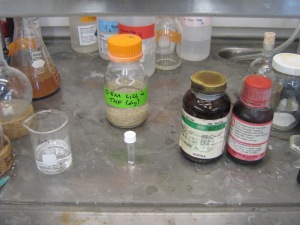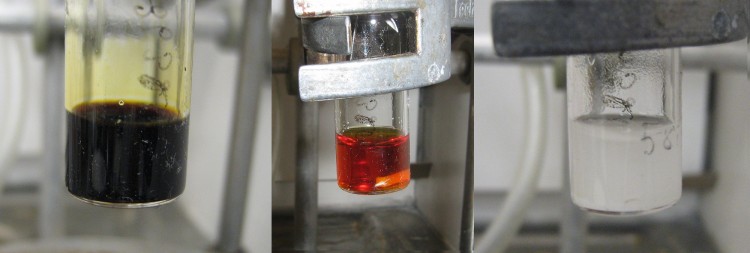Recently I’ve been doing a mix of Grignards, Wittigs ,and alkyl
lithium preps, necessitating quite a few titrations. At the start I was
dreading the (imagined) work involved, but in truth the process is
quite painless.
Everything needed for the Grignard reagent iteration :
Step 1. Pick a procedure.
There are a large number of different reagents that have been used at one time or another for organometallic titrations, each with their own pros and cons. I prefer diphenylacetic acid for alkyl lithium (nBuLi, etc.) titrations and iodine/lithium chloride for Grignard reagent titrations. If you want a one-size fits all approach, I2/LiCl will work for RMgX, RZnX, and primary/aromatic organolithium reagents.Step 2. Dry and load your glassware.
As in most small scale reactions, these titrations are best run in a 4 mL sample vial. Dry the vial (stir bar optional) in a 130 degC oven overnight before use, then cool in a desiccator. The vials I use can contain the smell of isocyanides, so I consider them air-tight.When the vial is dry, add 50 mg of either diphenylacetic acid or I2. Iodine will react with the septa, and so should be titrated that day. In vial under argon solid diphenylacetic acid is stable for prolonged periods, so I recommend preparing a few samples well in advance.
Step 3. Add the solvent.
For the diphenylacetic acid titration, freshly distill or dry under molecular sieves tetrahydrofuran. Under argon flow, add one millilitre to the vial and stir/shake until the indicator is dissolved.For the iodine titration, add 42.3 grams of LiCl to 200 mL dry THF (adjust the scale as needed). Stir for one day, then add 40 grams of 3A molecular sieves. Store sealed, away from light or moisture As above, add one millilitre of this mixture to the indicator.
Step 4. Titrate
While the organolithium bottle is under argon, insert a 1 mL syringe. Draw up gas three times, each time emptying the plunger over a small beaker of either n-butanol or isopropanol. Draw up 0.3-0.8 mL of organometallic solution, carefully determining the volume. Once the reagent has been measured, draw up a further 0.2-0.3 mL of gas, then withdraw the needle such that this argon blanket sits between the tip of the needle and the solventMaintaining this orientation, insert the needle into the vial and expel the argon blanket. Carefully add the organometallic reagent one drop at a time, checking for either the appearance (diphenyl lithium) or absence (I2) of colour. To ensure that the full quantity of reagent enters the THF solution, place the needle on the wall of vial, roughly 3 mm above the solvent.
When you are approaching the primary endpoint, slow the rate of addition. When the colour just persists/vanishes, record the volume of reagent added. Dispose of the remainder by slowly adding it to the beaker of butanol/isopropanol, then further quench the waste beaker via slow addition of ethanol or methanol.
Step 5. Calculate
The formula of interest:Molaritystock = Massindicator/(MWindicator/Volumestock)
Mass of the indicator is in milligrams, volume of the stock is in millilitres. With most syringes this value is accurate to two significant figures, though if necessary a Hamilton syringe can be used to give three sig. figs. If precise concentrations are required take the average of three titrations.
MW diphenylacetic acid: 212.24 g/mol
MW Iodine: 253.81 g/mol
Step 6. Cleanup
Both titrations can be quenched with methanol, then disposed in standard organic waste. Be careful with the lithium chloride solution, as LiCl is a potent skin sensitizer.1. Like all ethers THF forms peroxides on standing. Check for peroxides annually with a starch/iodide test strip, and dispose of any positive samples.
2. For Grignards and nBuLi I use a disposable 1 mL BD insulin syringe, with 22 G needle. For tBuLi or other highly flammable reagents I recommend a dedicated teflon/glass syringe, like these ones sold by chemglass. Dry the teflon syringe in a vacuum desiccator before use, never heat.
3. Always keep a bottle of sand nearby for small organometallic spills and a fire extinguisher within reach for larger fires. Reorganize the fumehood so that flammable solvent bottles (especially diethyl ether) are far from the area in which you are working.
4. This prevents the reagent from reacting with air or dripping from the tip. Either situation can cause a fire under the wrong circumstances.













No comments:
Post a Comment